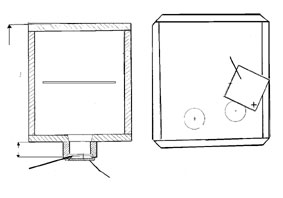Issue 12
Tasting Australia
Byron Bay Bushfood business showcases regional Australian native foods at Tasting Australia.
Byron Bay Native Produce is an innovative Australian native foods business, located in the Byron Bay hinterland on the north coast of NSW. Their range of produce is indigenous to the subtropical rainforests of eastern Australia. Byron Bay Native Produce is a wholesale supplier to the catering industry of a unique range of Australian native foods. Their new produce range featured for the first time at the Australian Regional Culinary Competition for Tasting Australia, in 1999. The competition was aimed at bringing a national and international focus to our regional produce. Teams were judged on culinary expertise, imaginative use of regional produce and presentation.
This was the first time that the Northern Rivers region had been represented at the Adelaide Food Festival. Local Chefs from the northern rivers region, Petar Ilic and Robert Hassall, with two apprentices competed in the competition.
The team prepared a 3-course menu for 4 persons. Each dish was designed to include an indigenous product from the region. The menu featured steamed oysters with a native Finger lime dressing, crispy skin Flathead tails, seasoned with Byron Bay Native Produce "BBQ Rainforest Spice Mix", Yamba Prawns, served with baby greens and a White Aspen dressing and aged beef, topped with Native Tamarind and anchovy butter.
Competition judges said the standards of this year's competitors were "300 per cent higher" than the 1997 event. Mr Graham Latham, one of the judges and Director of International Education and Development with Le Cordon Bleu Group in Paris, said of the team's efforts: "The oysters with Finger lime were exceptional and stood out in a class of their own. The lime "caviar" was unique and added a beautiful dimension to the taste of the oysters."
Erika Birmingham, of Byron Bay Native Produce, said: "We are very excited at the response we have received about our new product range. We have been researching and developing varieties of the Australian Finger lime for over 5 years and this is the first time that they have been showcased in the international arena. The response has been overwhelming."
The culinary competition was sponsored and filmed by Lifestyle Channel, which will screen highlights in programs for the Foxtel and Austar networks. Byron Bay Native Produce was also proud to be a sponsor.
Eat Your (Warrigal) Greens!
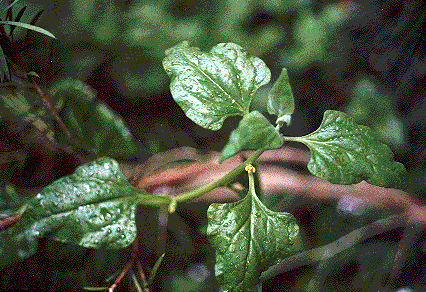 Warrigal greens - Tetragonia tetragonoides, syn Tetragonia expansa
Warrigal greens - Tetragonia tetragonoides, syn Tetragonia expansa
Information Collected by the Editor from a number of sources
The only Australian plant to be cultivated internationally as a vegetable.
Tetragonia tetragoniodes syn. Tetragonia expansa
Botany Bay greens, New Zealand spinach, Sydney greens, Warrigal cabbage; kokihi (Maori, New Zealand), tetragon (France)
Leaves are thick and triangular, 242cm long, bright green and glistening as if covered in dew or line sugar crystals, especially on the undersides. This is a common shrubby herb of sheltered beaches, saltmarshes, arid woodlands and plains, extending into central Australia. It has escaped from cultivation overseas to become a feral plant in Africa, Europe and the US.
It was one of Captain Cooks many famous discoveries. First sighted along the coasts of New Zealand, and later at Botany Bay, it was cooked and eaten by the Endeavour crew to allay scurvy. Joseph Banks considered it to eat ' as well as spinage or very near it" and he took seeds to Kew Gardens. During the 1880s New Zealand spinach was promoted in European and American seed catalogues as a hardy, summer-growing spinach substitute. It was popular for a time, then faded into obscurity.
Warrigal greens was the first Australian native food plant to be introduced into Europe, late in the eighteenth century. In October 1769 this 'wild spinach' was found growing at Queen Charlotte Sound on the New Zealand coast by a shore party from HMS Endeavour. Seeds were taken home to Kew Gardens by Joseph Banks in 1772.
Warrigal greens, the new marketing name for this Australian herb, seems to have been coined from two older ones, Warrigal Cabbage and Botany Bay Greens. Warrigal was the Eora (Sydney area) Aboriginal name for the native dog or dingo.
These nutritious greens were added to the scant rations of the first British settlers at Sydney Cove in 1788. 'There is a Plant very like the Spinage in England which afford us a very good repast with a piece of- I was going to say Pork, but will call it Bacon,' wrote Lieutenant Newton Fowell of HMS Sirius.
On his way by boat to Parramatta in March 1793, the Spanish botanist Don Luis Née jumped ashore at Kissing Point (now Ryde) on the Parramatta River. 'I had hardly touched ground when I found two tetragonia? and various other oraches, all edible, as I pointed out to the colonists,' Née wrote in his journal.
'Botany Bay greens are procured in abundance,' wrote David Dickinson Mann in The Present Picture of New South Wales (London, 1811 }, 'and are esteemed a very good dish by the Europeans, but despised by the natives.' Seeds of 'New Zealand Spinach' were sent to the new settlement at King George's Sound, Albany, in WA in November 1826. In London, seedsmen Flanagan & Nutting offered 'New Zealand, or Tetragona Expansa' in their 1835 catalogue.
Warrigal greens are widely grown in home vegetable gardens in Australia and commercial quantities have been planted to supply restaurants and bushfood suppliers. It is grown as a summer spinach in Britain and the United States and is popular in France where it is called tetragon.
One reference states that 'Odd as it may seem, New Zealand spinach was rarely eaten by Aborigines. According to anthropologists working north of Lake Eyre, its use there among Aborigines was 'made known by the white man.' However Cherikoff (The Bushfood Handbook) and Isaacs (Bush Food)state that Aborigines ate the leaves raw or steamed.
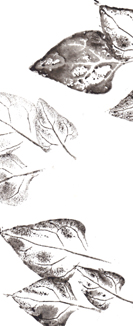
Temperate to tropical
Sandy and stony beaches, sand dunes and salt marshes on the coasts of Australia, New Zealand, Lord Howe Island and Pacific Islands; also inland plains.
Also cultivated in most soil types in moist, semi shade positions with light or no frost (little is known of frost tolerance).
A spreading creeper with thick, succulent stems, scrambling by nature.
Distinctive arrowhead-shaped leaf - soft, flat, shiny, dark green.
Tiny yellow star-flowers in the bracts between the leaves ripen into hard seed containers in warm weather. (Please note in harvesting that even the immature seeds can be hard and rather painful if not removed before eating).
Warrigal greens are easy to grow from seed and make a good substitute for the 'true' or English spinach to which they are not related. They adapt to hot, dry and sandy soils and resist salt spray. Once established, plants resist drought and provide year-round 'cut and come again' crops in all but the coldest climates. However, the editor has experienced difficulty with greens in a full sun position (stunted, rather yellow foliage) and has had little luck in regrowth after 'pruning'- the exception to this being vigorous plants which were tip harvested at the beginning of the season (spring). Cherikoff (The Bushfood Handbook) suggests that harvesting takes place in late winter but I have found that my crop extends well into mid to late summer (most especially those plants protected from full sun).
Before planting, in spring and summer, pour hot water over the seeds and leave them to soak overnight. Next day, sow them about 60cm apart in a shady spot, and just cover them with soil or compost. In cool places, sow seed in pots under glass and transplant seedlings to the garden when there is no danger of frost.
The plants mature in about 10 weeks. If you allow one or two plants to set seed, new plants will spring up each year. Editor's note - just try to stop them setting seed!!
Plants need little water except in very dry weather. Editor's note - my greens have definitely performed best under moist conditions.
Warrigal greens, like lettuce, can be grown without soil using the hydroponic method.
Lightly blanch warrigal leaves to remove mildly toxic oxalates. Blanch the leaves in boiling water for about one minute, then plunge them into cold water immediately. This will keep their green colour. Drain. Discard the water.
Wilted warrigal greens make an attractive, colourful bed for a kumara patty or a piece of barbecued fish. Use young leaves in salads. The slightly tart flavour will be lifted by a touch of lemon juice or a French salad dressing.
Cook and then blend with onions and potatoes and serve hot or cold. Thin with milk, if necessary.
Try fresh (blanched) warrigal greens with bush tomato chutney or in a pesto sauce with macadamia or bunya nuts.
Index 12
The People of Yarrawarra Aboriginal Corp
Bush Dust - The Spicy Tasmanian
The People of Yarrawarra Aboriginal Corp.
MICHAEL McDOUGALL
I have been working at Yarrawarra since we first started in 1987. I am a Gumbaingirr Elder, and I have been in this area for most of my life. I joined the Bush Tucker group when it was set up at Yarrawarra. I take the kids and visitors on the Bush Tucker Walk and Site Tours. I also teach them about my people and my country. Sometimes it's a bit complicated when people ask too many questions, but other times it is really good when they listen and learn.
I hope that sometime in the near future the young ones will carry on with my work. As I was walking along Corindi Lake looking for crabs in the 1980s, I stumbled across a canoe half-sticking out of the sand. I went home grab a shovel and started digging around the canoe until I eventually got it out of the sand. It was heavy, waterlogged and hard to move.
The Australian Museum took the canoe away and cleaned and preserved it. They returned it to the community, where it is now displayed at Yarrawarra in a glass cabinet. The canoe was carved from honeysuckle banksia, and was very old. The honeysuckle banksia is still an important tree to us, for timber, firemaking, food and medicine. IAN BROWN I am a Gumbaingirr guri and have been employed by Yarrawarra Aboriginal Corporation for the last five years as a bush food and medicine guide. I am heavily involved with cultural issues in the Gumbaingirr area, and I am a Gumbaingirr representative working with universities, National Parks and Wildlife Service, local councils and State Forests in archaeological research, field surveys, monitoring earthworks etc.
I am also involved with Dunecare, Landcare and boardwalk construction. I was introduced to bush foods and medicines by my father as a young child. I also continue to be taught by the Elders, who are held in great respect. Without the Elders the cultural knowledge of the landscape would not exist. Keeping the culture alive is my main concern, and to this end I practice what I preach. I utilise traditional bush medicines and foods in every facet of everyday life. I am very interested in passing the knowledge to anyone willing to learn, as this not only helps them, it helps me with my learning through discussion and it jogs my memory. My favourite plants are the nyum nyum bush (coastal bearded heath) and bloodwood, which I use extensively as an antiseptic and natural dressing for wounds. I am a modern Gumbaingirr man embracing traditional methods of hunting and gathering, medicine and culture, living it, teaching it and passing it on.
I am currently employed at Yarrawarra Aboriginal Corporation as a cultural tour guide. I am of Gumbaingirr and Bundjalung descent, and I have been involved in a variety of government and private enterprise throughout my working life. Over the two and a half years I have been at Yarrawarra, I have obtained my Senior First Aid certificate, Aboriginal Sites Officer ticket. I have also been involved with research into bush foods and medicines. I really enjoy working with the University of New England team doing archaeological research on local Aboriginal sites at the request of the Aboriginal community. We have just published our first book, called 'Arrawarra meeting place' which shares Aboriginal stories about some important places, combined with Gumbaingirr language, recipes, pictures and scientific data. My favourite time of year is when the paperbarks are flowering and it's the time to catch sea bream.
From the AQIA Conference - Aug 1999
This is an extract from a paper presented by Lin Andrews. It addresses some of the issues facing growers and others who are forming organisations to support their industry.
ESSENTIAL ORGANISATIONAL STRUCTURE
• Production.
• Marketing.
• Administration.
Let us turn our attention to each of these components:
Production
It is clear that if we cannot produce a product of consistent quality and of regular minimum supply, we do not have a business. The very foundations of any organisation are its ability to produce a product or service. Under the heading of production we have a series of sub-headings. For this particular association they may include some of the following:
-
Research - tree quality, fruit production, harvesting and processing.
-
Root stock availability:
-
Seedlings
-
Graftings
-
Other.
-
The availability of fruit:
-
Who will produce?
-
When?
-
What quantities?
-
The availability of whatever product:
-
Who will process?
-
Contractor or Merchant?
-
Quality assurance programs;
-
Definition of standards.
-
Who will police the standards?
-
Rewards/recognition, penalties.
-
Trade contracts for minimum supply:
-
Supplied to who?
-
What about over-supply?
Marketing
This is an extremely large subject and we may deal with some of the basic components of marketing later in this session, but the principle points of significance are as under: The type of product which you are going to produce as an individual or as a private company or as an industry. These may include the following: Unprocessed fruit.
-
Cut and processed fresh fruit.
-
Dried fruit.
-
Jam.
-
Chutney.
-
Beverages.
-
What are we selling? Is it bushtucker? Is it a gourmet dish?
Name recognition
Are we selling Quandongs, which is a name that has no recognition outside of the local group of consumers and casual harvesters, or are we selling desert peach or wild peach?
Note that the Chinese Gooseberry failed, but the Kiwi Fruit is distributed to most countries of the western world.
Who is our market?
Are we going to sell to gourmet food stores or to the bushtucker set? Is it farm-door, country, city, or export? Until we have a keen vision and definition of the end consumer, we will not even begin to understand how we should pack our food or what distribution channels to use. How do
-
Rewards/recognition, penalties.
-
Trade contracts for minimum supply:
-
Supplied to who?
-
What about over-supply?
Marketing
This is an extremely large subject and we may deal with some of the basic components of marketing later in this session, but the principle points of significance are as under: The type of product which you are going to produce as an individual or as a private company or as an industry. These may include the following: Unprocessed fruit.
-
Cut and processed fresh fruit.
-
Dried fruit.
-
Jam.
-
Chutney.
-
Beverages.
-
What are we selling? Is it bushtucker? Is it a gourmet dish?
Name recognition
Are we selling Quandongs, which is a name that has no recognition outside of the local group of consumers and casual harvesters, or are we selling desert peach or wild peach?
Note that the Chinese Gooseberry failed, but the Kiwi Fruit is distributed to most countries of the western world.
Who is our market?
Are we going to sell to gourmet food stores or to the bushtucker set? Is it farm-door, country, city, or export? Until we have a keen vision and definition of the end consumer, we will not even begin to understand how we should pack our food or what distribution channels to use. How do we find the end user? What does he look like? Where does he live? How do we contact him? What can he afford? Why will he buy from you?
Administration
Without effective administration we will not have production and we will not have marketing. Even this function on this weekend was brought about by somebody's intense administration in drawing us all together for this talk-feast or think-tank depending on whether you are participating or one of the quiet ones listening and about to give us all of the answers.
Somewhat Useful...
From: "Australian Bush Products Email: jonesc@lm.net.au
Subject: seed collection
Hi Sammy ands other bushfood enthusiasts. Sammy your pole idea and black plastic should work well in collecting Acacia seeds. In some species it is appropriate to hand collect particularly when the seeds are ripe and opening. But your idea works well with the prickly varieties. We generally place a large box under the branch and strip. We collect mostly by hand, and lay the pods on plastic sheets to dry out in the full sun. Ants love this, so we normally spray the plastic before it is put on the ground, sprayed side down. This rids the area of ants. Ants can be quite helpful out in the field for collecting, as they collect and stockpile the seeds under the bush near the entrance to their tunnels. By collecting the little heaps you can collect quite quickly. These seeds are suitable for propagating plants from. However it doesn't stop them wanting a second bite once you've collected them and put them aside for storage, so always store in a sealed metal container, eg. a coffee tin. With ripe Acacia seeds, the time exposed for drying need only a week to ten days. Then will be dry enough then to package.
Alternatively if you only have very small quantities, the pods can be air dried in a paper bag. It must be paper, not plastic though. Hang or leave in a dry place. Not too sure about the dehydrator, because some forms of heat and drying may kill your seed - this may be fine if you are wanting to use the seed for damper, but not if you want to eat some and plant some for later. The sieves we use are of three different gauges of wire from large down to flywire size. The only real way to rid shucks from the seed is to capitalise on the wind by winnowing. This works excellently and saves a lot of time hand cleaning. I am happy to share with you other collecting and cleaning tips, which we have gained through personal and horticultural experience.
Hope this helps you. Bye for now. Chris Jones Thanks Chris My own thoughts. With some species, the ground sheet is the way to go - very frustrating to be hand picking into a container and finding much of your pod falling onto the ground! I have yet to find the ideal fabric for a ground sheet - for most species you will need a sheet at least 5m x 5m - rather cumbersome!
I have, fortunately, had no problems with ants - in fact I have had nil pests or other dining guests in my one season of harvesting wattle seed.
With the drying - I was using a heat of only 45c - hard to tell if this would effect viability - would doubt it when you think about the pre-treatment we usually gives these seeds (boiling water, etc).
As for winnowing - I set up an old fan and sat in the morning sun, winnowing away like crazy - OK for small amounts but when you have a substantial harvest this can be rather time consuming!
Winnowing
'The 'Lundomatic Seed Cleaner' Plans of the Seed Cleaner provided by Greening Australia Queensland.
This low cost seed cleaner works on the principle of vacuum assisted winnowing. It in nicknamed the Lundomatic Seed Cleaner after Brian Lund the original maker. At this stage, the plans are rudimentary and as soon as a description of the operation of the device is to hand, we will include it here.
Seed Cleaner - from Brian Lund of Greening Australia, Qld
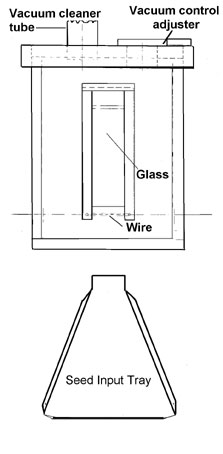
Side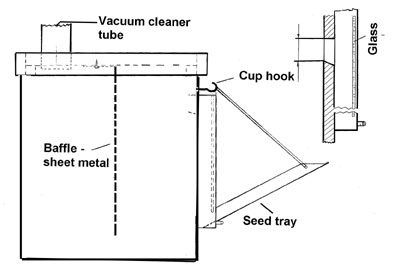 Cutaway
Cutaway
Cutaway top
